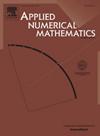Fast algorithms of compact scheme for solving parabolic equations and their application
IF 2.4
2区 数学
Q1 MATHEMATICS, APPLIED
引用次数: 0
Abstract
Based on existing work on compact scheme, particularly utilizing the Crank-Nicolson scheme for time derivatives and compact difference schemes for spatial derivatives in solving linear parabolic equations, we propose a fast algorithm of the scheme to solve the systems for the first time. Given that the resulting coefficient matrices of the scheme are diagonalizable, we transform the matrix-vector equations into a diagonal component-wise system, utilizing modified discrete cosine transform (MDCT), discrete sine transform (DST), and discrete Fourier transform (DFT) to optimize CPU time and reduce storage requirements. Moreover, the algorithmic technique facilitates a novelty and simple convergence demonstration strategy in the discrete maximum norm that is easily extendable to high-dimensional linear cases. The computational framework is also extendable to three-dimensional (3D) linear case and semi-linear case. Numerical experiments are given to support our findings.
求解抛物型方程紧凑格式的快速算法及其应用
在现有紧致格式研究的基础上,特别是利用时间导数的Crank-Nicolson格式和空间导数的紧致差分格式,首次提出了求解线性抛物型方程组的一种快速算法。鉴于该方案的结果系数矩阵是可对角化的,我们将矩阵向量方程转换为对角分量系统,利用改进的离散余弦变换(MDCT),离散正弦变换(DST)和离散傅立叶变换(DFT)来优化CPU时间并减少存储需求。此外,该算法还提供了一种新颖而简单的离散最大范数的收敛证明策略,易于推广到高维线性情况。计算框架也可扩展到三维(3D)线性情况和半线性情况。数值实验支持了我们的发现。
本文章由计算机程序翻译,如有差异,请以英文原文为准。
求助全文
约1分钟内获得全文
求助全文
来源期刊

Applied Numerical Mathematics
数学-应用数学
CiteScore
5.60
自引率
7.10%
发文量
225
审稿时长
7.2 months
期刊介绍:
The purpose of the journal is to provide a forum for the publication of high quality research and tutorial papers in computational mathematics. In addition to the traditional issues and problems in numerical analysis, the journal also publishes papers describing relevant applications in such fields as physics, fluid dynamics, engineering and other branches of applied science with a computational mathematics component. The journal strives to be flexible in the type of papers it publishes and their format. Equally desirable are:
(i) Full papers, which should be complete and relatively self-contained original contributions with an introduction that can be understood by the broad computational mathematics community. Both rigorous and heuristic styles are acceptable. Of particular interest are papers about new areas of research, in which other than strictly mathematical arguments may be important in establishing a basis for further developments.
(ii) Tutorial review papers, covering some of the important issues in Numerical Mathematics, Scientific Computing and their Applications. The journal will occasionally publish contributions which are larger than the usual format for regular papers.
(iii) Short notes, which present specific new results and techniques in a brief communication.
 求助内容:
求助内容: 应助结果提醒方式:
应助结果提醒方式:


